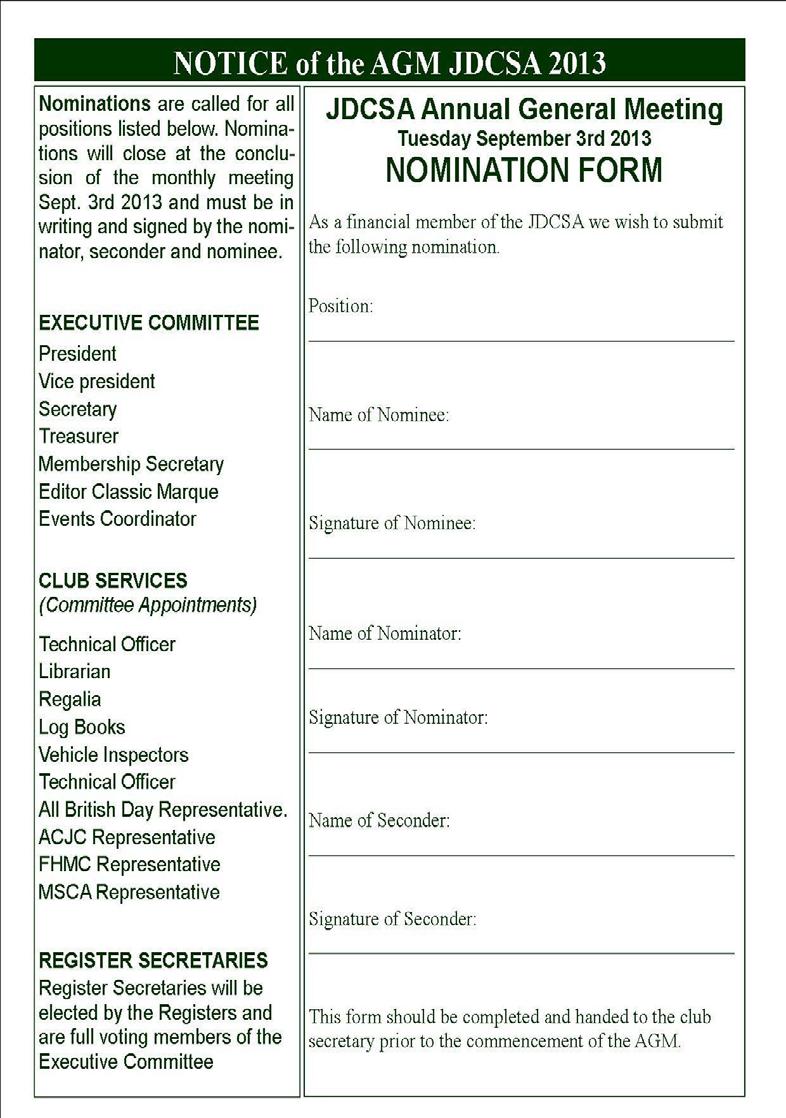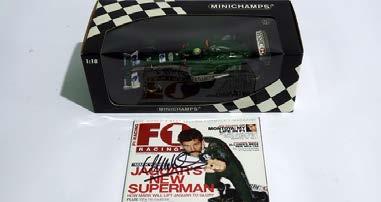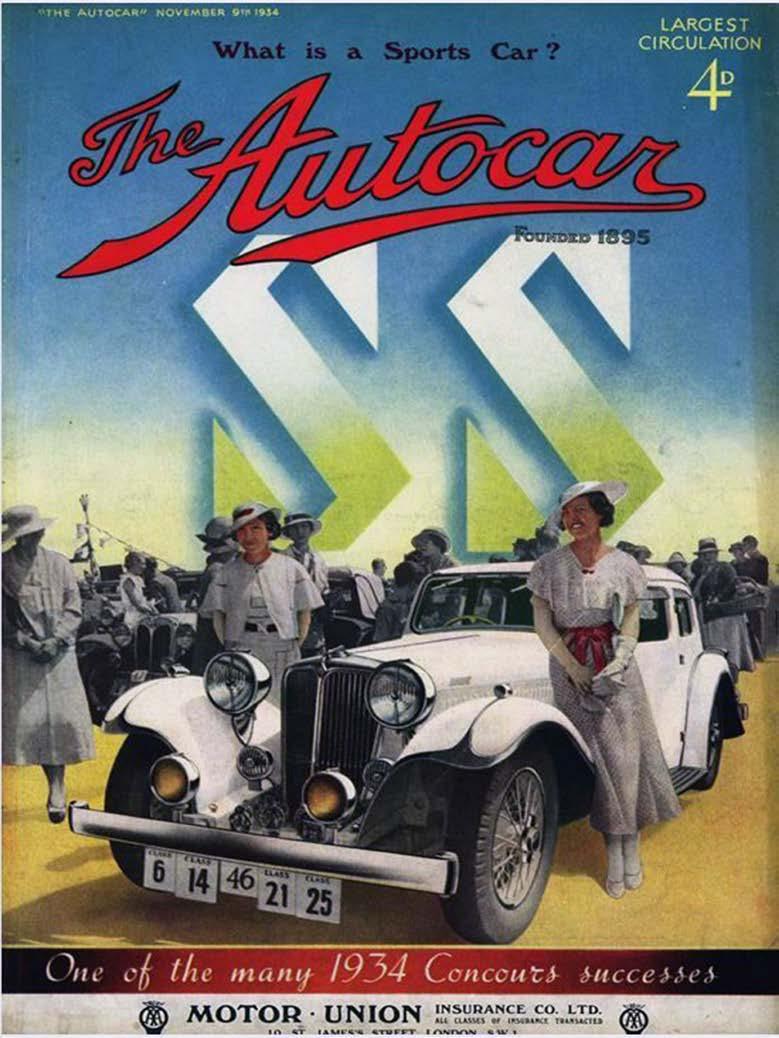
11 minute read
SS & Jaguar Saloons (1931-1949

The Swallow Sidecar Company was founded in 1922 by motorcycle enthusiasts, William Lyons and William Walmsley. Originally making motorcycle sidecars before developing bodies for passenger cars. The business then extended to complete cars made in association with Standard Motor Co. The S.S.I. (the top of its radiator says ‘SS One’) was a two-door sports saloon and tourer built in Foleshill, Coventry, England. It was first presented to the public at the 1931 London Motor Show. The car was initially supplied as a fourseater fixed head Coupé. In 1933 a tourer was launched. With a top speed of 75 mph (121 km/h), The S.S.I. was noted for its value-formoney and attractive appearance, rather than its performance. It initially used either a 2.0 litre (2054 cc) or 2.5 litre (2552 cc) six-cylinder side-valve Standard engine. The chassis was also made by Standard. In 1932 the basic Coupé cost £325. In 1933 the chassis was changed to underslung suspension and modified to give a wider track and better front footwells. The gearbox also gained synchromesh.
S.S. Cars Limited - S.S.I.
In 1934 Walmsley elected to sell-out and in order to buy the Swallow business Lyons formed S.S. Cars Limited, finding new capital by issuing shares to the public. The cars initially retained the name SS. For 1934, a four-light saloon version of the S.S.I. was built, a machine that shared almost everything with the Coupé, but with new glass rear windows in lieu of the Coupe’s carriage top with false irons. In 1935 an Airline Coupé and drophead Coupé were added to the range. The car was 15’ 6” (4.72 m) long and 5’ 3.5” (1.613 m) wide (growing to 5’ 5½” in 1934), and typically weighed 2300 pounds (1043 kg). The engines were enlarged to 2.1 litre (2143 cc) and 2.7 litre (2663 cc) for the 1934 to 1936 models. Body style in order of introduction: - • 2-door 4-seater: • fixed head Coupé • tourer • sports saloon • Airline sports saloon • drophead Coupé In total just over 4200 cars were made.
(continued page 12)
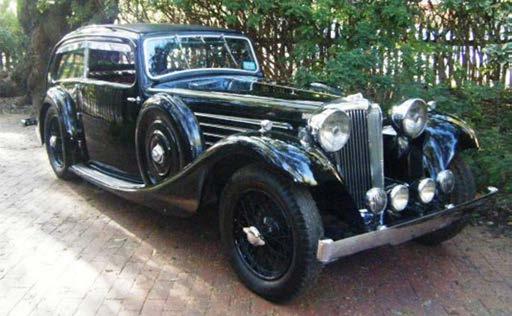
1935 S.S.I. Airline Sports Saloon. This car (one of 600), was owned by Jack Jeffries until the early 40s. It was restored by Ron Campbell, who owned the S.S.I. for over 20 years. It passed to Bryson Industries who used it for promotional purposes until 1978 when it became part of the Rainsford family collection where it spent most of this time on display at the National Motor Museum at Birdwood in South Australia, before being sold to an overseas buyer.
1934 (2143cc) Swallow S.S.I. Four-Seat Fixed Head Coupe. Delivered new in 1934 to a Government official in London. When he moved to Australia in the ’40s, he brought the car with him and it promptly disappeared. Subsequent owners left it to steadily decay before it was rescued in 1997 by retired farmer and panel shop proprietor Norm Archer who restored the car to immaculate condition. To read more go to: Unique Cars SS1.

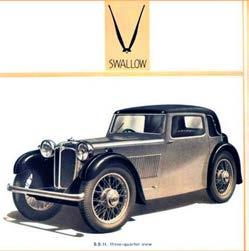
Illustration of a S.S.II. Series 2 with it’s cycle type wings and carriage top with false irons. Original photographs of the early S.S.II.’s Series 1 are virtually non-existent.
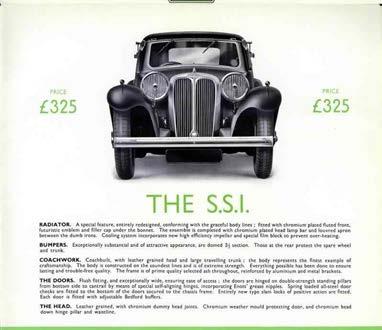
Swallow S.S.II.
Somewhat overshadowed by the larger S.S.I., the S.S.II. offered a more compact and affordable sporting car to the motorist of the early 1930s. Introduced in 1931, there was one major difference between the S.S.I. and S.S.II.. Standard constructed the S.S.I. chassis exclusively for Swallow to fit the body. The chassis used for the S.S.II. was a regular Standard Nine chassis. The S.S.II. was smaller in every aspect compared to the S.S.I., but that is only clearly visible when the cars are lined up together.. Both models used Standard engines, but the S.S.II. used a four-cylinder 1.0 litre side-valve engine. The rakish looks of the S.S.II. somewhat belied the performance on offer from the Standard engine, with a meagre 27bhp on tap to propel this neat little Coupé in its initial form. It was the good looks and affordable price that made the S.S.II. successful. To spice up the performance of the S.S.II., two larger engines were available in the Series 2 introduced in 1934. These were the 1343 cc 32 bhp and 1608 cc 38 bhp versions.
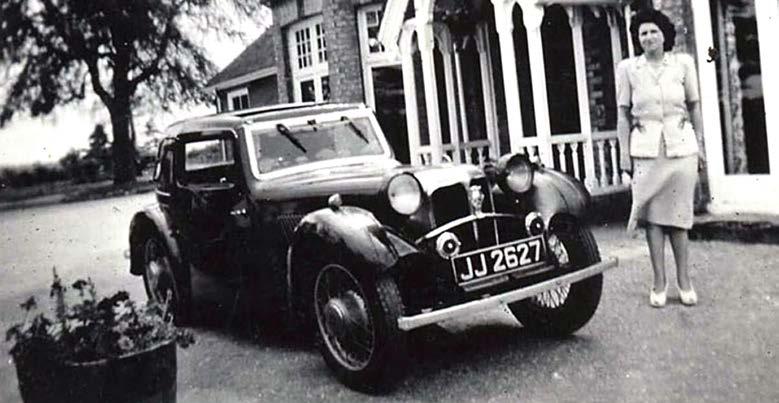
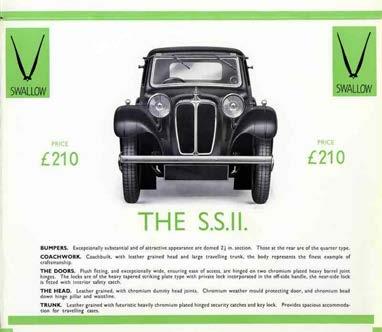
A slightly larger wheelbase to offer the occupants a little more room, a fourspeed gearbox and servo operated drums were also part of the Series 2 package. Two versions were available, the Saloon and the Coupé, both of which were very similar except for the fabric covered rear quarter windows on the Coupé. Production of the S.S.II. continued for 5 years, with a healthy 1801 examples of the car being produced. So, for Sir William, it was a useful money earner.
(continued page 13)
1937 SS Jaguar 3½ litre with the single fender mounted spare tyre. In 1936 and 1937, Jaguars still had wood framed bodies. It was not until 1938 that the company started using all steel construction techniques. Problems with the new process almost halved production in 1938. By the start of the war Jaguar had produced over 14,000 cars.
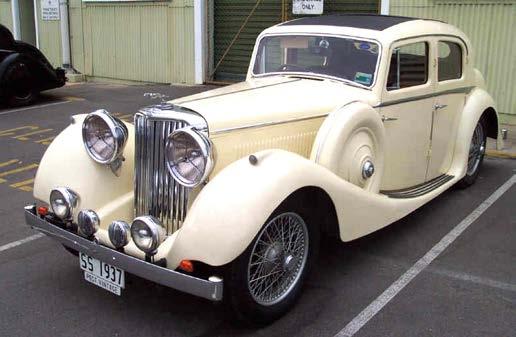
SS Jaguar 1½ litre, 2½ litre and 3½ litre
saloons
These were produced as a four-door saloon and as a drop-head Coupé, both seating five. The 1½ litre cars are somewhat smaller than the 2½ and 3½ litre cars. The early 1½ litre engine was a side-valve four, later an OHV four replaced it. The 2½ and 3½ used the William Heynes developed version of the overhead-valve six as used in the SS-100. The cars also used an uprated Standard synchromesh gearbox and the latest Girling hydraulic brakes. The 1935-37 models had a single fender mounted spare tyre; the 1938-40 models had the tyre under the boot in a compartment. The radiator shell had vertical chrome bars. The front sidelights on early cars are a separate chrome unit, but on later cars were done by welding a pod onto the fender and blending in with lead. Horns are generally visible, mounted on the bumper or under the headlights. Some cars have fog-lights. The door handles are below the chrome side trim on early cars, but in line with the trim on later cars. The tyres were 18” rim diameter with wire spoke wheels, with the chromed knock-off hub having the SS logo. The optional Ace discs covered the spokes to give the appearance of disc wheels. Badged as a Jaguar for the first time, the 2½ and 3½ cars wore huge Lucas P100 lamps and like the 1½, featured an integrated boot complete with a tray of tools, the start of a long-standing Jaguar tradition. (continued page 16)
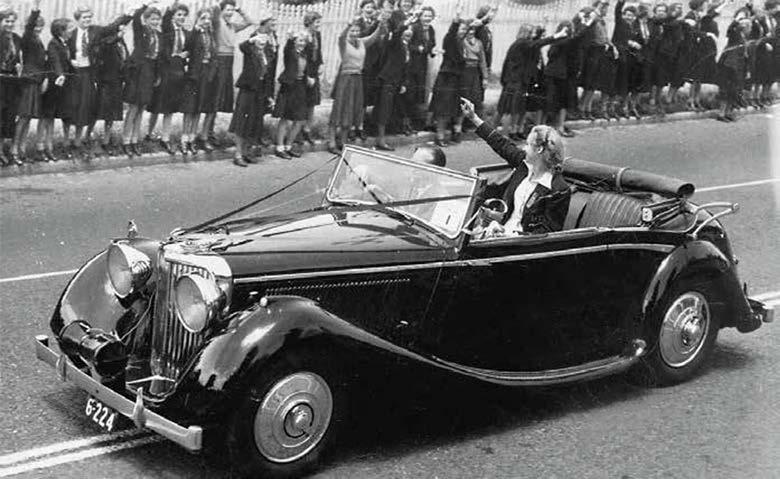
S.S.I. and British Racing Driver the Hon Brian Lewis (centre) with Sir William Lyons (right) at the SS’s front door prior to the 1935 Monte Carlo Rally. Plaques by the doors denote the registered offices of the Swallow Coachbuilding Company and SS Cars Ltd.
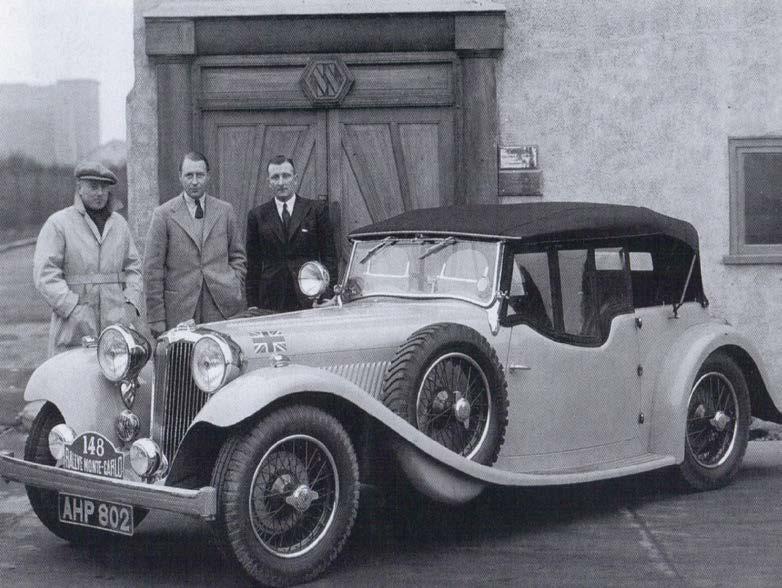
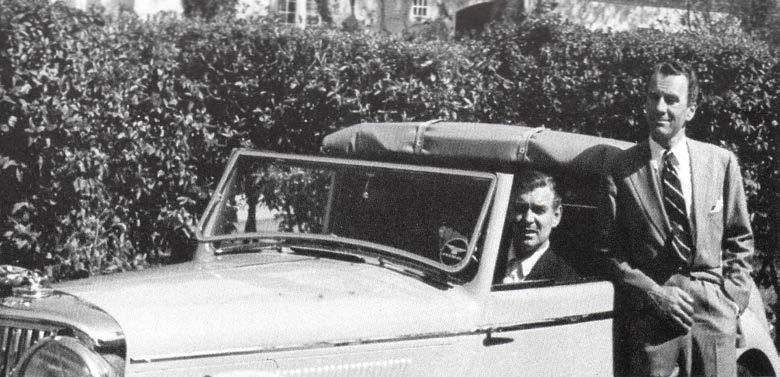
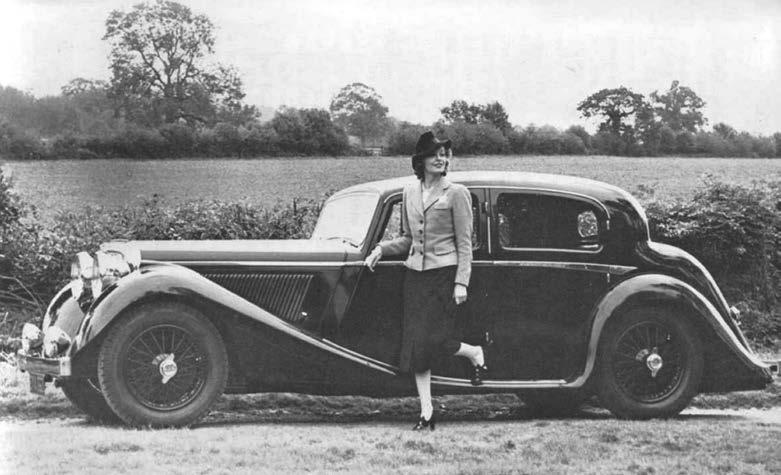
The cars produced in 1938 had an all steel body which was a breakaway from traditional coachwork of steel panels on an ash frame.
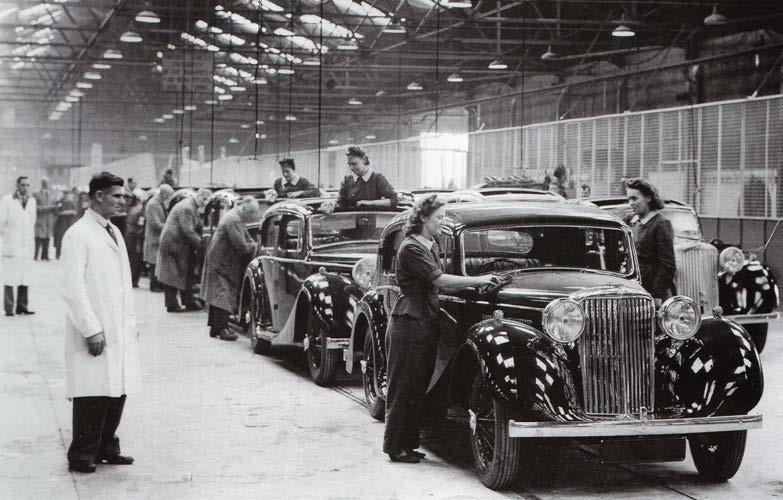
(Continued from page 13)
The SS Jaguar saloon was described by The Autocar Magazine as “a real masterpiece of aesthetic and practical proportioning”. There were a few special bodies done by various other coachbuilders including Graber, Saoutchik, Beuttler, Van den Plas and a Mulliner divided limousine for Standard’s director Sir John Black.
Mark IV Jaguar The name Mark IV was never an official factory designation for the 1945-48 cars, but has been unofficially hung on these by the aficionados ever since the early ‘50’s.
All the Mark IV’s were built on a separate chassis frame with suspension by semielliptic leaf springs on rigid axles front and rear. Mechanically these are the same as the pre-war saloon range and were produced in saloon and DHC form. The 2.5 and 3.5 engines were now produced by Jaguar, Lyons having bought the tooling from Standards, who continued to supply the 1.5 engine, making it the last Jaguar to be built with an outsider engine. Visual differences between these and the pre-war SS Jaguar saloons are very minor. The radiator badge reads “Jaguar” with the engine size, the SS logo having been eliminated. The badge in the centre of the rear bumper is a “J”, replacing the “SS”. The tires are 18” rim diameter with wire spoke wheels, and optional Ace discs covered the spokes to give the appearance of disc wheels. The wheel knock-off hubs also say Jaguar rather than SS. The pre-war 1½ litre cars were available as a saloon or drophead Coupé, but post war, only the closed model was made. Performance was not a strong point but 70 mph (113 km/h) was possible. The car featured the same cabin dimensions and well-appointed interior as its longerengined brothers. Despite its lack of outand-out performance, a report of the time, comparing the 4-cylinder 1½-litre with its 6-cylinder siblings, opined that the smallest-engined version of the car was “as is often the case ... the sweetest running car” with a “big car cruising gait in the sixties”. The 2½ litre cars were approximately 300mm longer than the 1½ litre to accommodate the six-cylinder engine. The passenger compartment was the same size. The 3½ Litre, was essentially the same body and chassis as the 2½ Litre and the larger 125 bhp engine gave better performance but at the expense of economy. The rear axle ratio was 4.25:1 as opposed to the 4.5:1 on the 2½ Litre.
Production
• The 1½ Litre ceased in 1949. From 1935-1949, 10,980 cars were built. • The 2½ Litre ceased in 1948. From 1935-1948, 6,281 cars were built. • The 3½ Litre ceased in 1948. From 1937-1948, 3,162 cars were built. The cars were succeeded by the Mark V (1948-1951). .
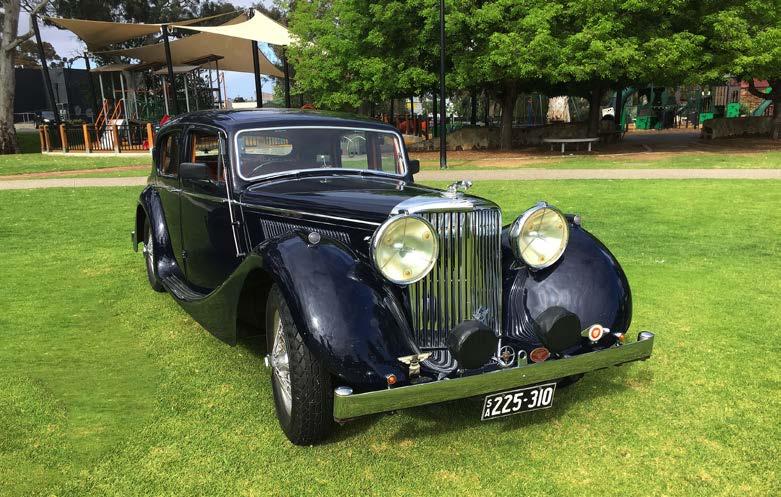
There were a few special SS saloon bodies done by various coach-builders including Swiss Carrosserie Hermann Graber
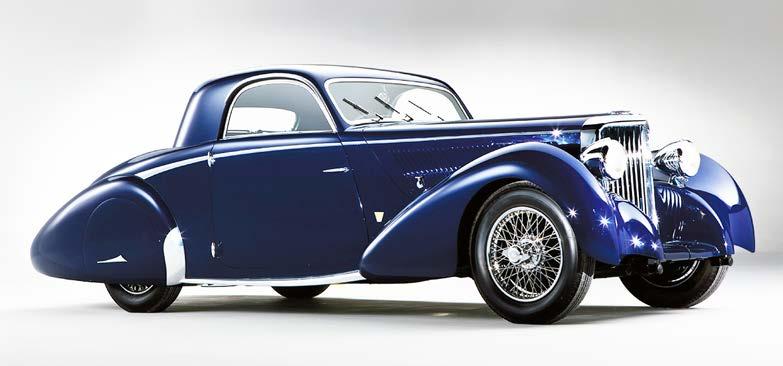
Graber, bodied several Jaguars, one of which is this wonderful SS Coupe one-off. The car was shipped as a bare saloon chassis to Hermann Graber at Wichtrach, near Berne, Switzerland, in May 1938. Graber fitted the SS saloon chassis (#30182X) with a two-door, twowindow, five-seater Coupé body for one Monsieur Michel Dionisotti of Geneva. It is believed to have been finished in black over grey with a grey leather interior and built-in radio. It has two pull-down occasional seats in the back and also has a door for skis. The car was initially fitted with large Lucas head lights, which are now replaced by smaller examples. On March 31, 1949, the car was registered in Switzerland as a ‘Limousine Coupé’ to Enterprise de Grads Travaux S.A. of Lausanne. In 1953, the car was registered to “Labhart Thelma Violet” of Geneva but was eventually believed to have been purchased by a Canadian serviceman who returned to Canada with it. By May 1956, Brian Metcalfe of Ontario owned it before it was eventually purchased by Frederick Corp, who drove it until 1963, when he placed it into storage. The car then passed through at least three known North American owners before David Gill of Chicago purchased the car in 1987 and commissioned its restoration. The car was dismantled, and the restoration began but for some reason it was halted. Kathy and Gerald Nell purchased the car in 1990. The Nells bought the car in pieces but were able to amass substantial records, and they were lucky to find previous owner Fred Corp, who confirmed that it had been his car. Corp was instrumental in the correctness of the restoration. When RM Auto Restoration restored the car in 1994, they asked the Nells if they’d like some sloppy welds cleaned up, where Graber had extended the frame at the rear. The Nells asked the car be kept original ‘and we got dinged for that at Pebble’, Kathy Nell said. The car was returned to as-new condition at a cost of $270,000, with the exception of being painted royal blue instead of the original black and grey. In 2010 the car was put up for auction by RM Auctions with an estimate of $500,000 to $700,000 USD. The Graber Jaguar one-off sold for $385,000 USD. Less than a year later, the car was offered again by RM Auctions at Villa d'Este with an estimate of $425,160 - $566,880 USD. The car did not sell with a hammer bid of $297,612 USD. The auctioneer said that it should have sold well, being so close
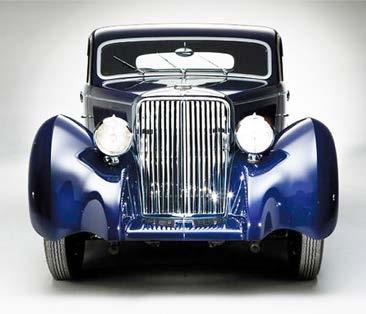
to the origin of its Graber coachwork and it’s hard to conceive why the bidders were so reluctant. .


